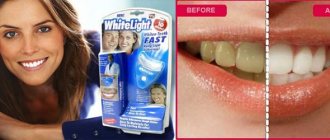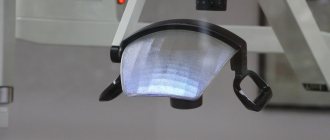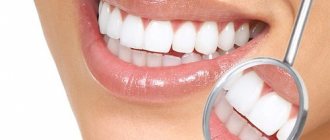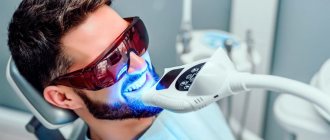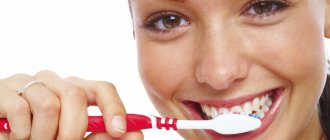Author of the article:
Soldatova Lyudmila Nikolaevna
Candidate of Medical Sciences, Professor of the Department of Clinical Dentistry of the St. Petersburg Medical and Social Institute, Chief Physician of the Alfa-Dent Dental Clinic, St. Petersburg
Over time, teeth acquire an increasingly distinct yellow tint, which is not to everyone’s taste, because it is difficult to come up with something more bewitching and attractive than a snow-white smile. Unfortunately, achieving, and most importantly, maintaining it is not so easy - there are so many temptations around. Coffee, tea, wine, berries, lemonades and other products significantly affect the color of enamel. The situation is aggravated by smoking, as well as poor oral hygiene.
If you notice that your teeth have become darker and want to correct it, don’t despair. Today there are many convenient and affordable ways to solve this problem. One of the most popular options among home procedures is whitening using special strips. Their advantages are simplicity, safety, relatively low price and the ability to take everything you need for the procedures with you, for example, on a business trip.
But before you start whitening, you need to familiarize yourself with the rules for using strips. This will not only help you avoid common mistakes, but will also increase the effect of these funds.
We suggest you read some simple but important tips.
How to whiten teeth correctly?
Step one: read the instructions
Be sure to pay attention to what is written in the instructions, even if this is not your first time doing whitening. Most products have similar methods of use, but due to the difference in composition there may be some differences in use. Therefore, read the instructions to the very end, paying special attention to possible side effects.
- Remember that improper use of any whitening products is dangerous to the health of your teeth. The fact is that the process itself causes weakening of the enamel, so you need to approach it carefully. The active substance applied to the strips may cause soft tissue irritation and other problems.
- Different brands of strips have different instructions, so every time you use a product from a new manufacturer, read the manual carefully.
Step two: brush your teeth
Before you begin whitening, brush your teeth thoroughly, otherwise food debris and plaque will prevent you from achieving good results.
Important:
- Do not whiten your teeth immediately after brushing them; do this at least half an hour after the procedure.
If you want to achieve maximum results, it is better to have the cleaning done by a dentist. There are several procedures that will help restore teeth to their natural color and get rid of hard and soft plaque. The most popular options: ultrasonic cleaning and cleaning using an Air Flow device. The first is necessary if you have tartar. The second is a more gentle procedure; food debris and soft plaque are removed using a special abrasive solution, which is released under pressure.
Step Three: Prepare the Strips
Before you fix the strips, make sure you are using them correctly. Some manufacturers produce strips of various shapes for the upper and lower teeth. In other cases, the products do not differ from each other. Be sure to figure this out when you decide to whiten.
- After you understand how to properly fix the elements, prepare the strips. The composition contains an active substance, most often it is based on hydrogen peroxide. The principle of operation is simple - oxygen is gradually released from peroxide, which penetrates the enamel, discoloring the pigment.
- The smooth side does not contain active gel; its main function is to make it convenient for you to stick the strips to your teeth.
Step Four: Apply the strips to your teeth
- Apply the strip to the front surface of your teeth with the gel side so that it completely covers the teeth, then smooth out any irregularities.
- In order to straighten the strip, it is convenient to use a toothbrush.
- Make sure that the strip actually covers the entire row of teeth, if you, of course, want to get a uniform result.
- Try not to get the gel on your gums, especially during the period of wisdom teeth eruption, otherwise perioronitis may occur; if necessary, remove it with a cotton swab, as long-term presence of the active substance on soft tissues can cause irritation.
Step Five: Wait
After both strips are attached to the teeth, all that remains is to wait a little. Do not touch the strip for the process to proceed correctly. The required time depends on the concentration of the active substance and other factors. Therefore, be sure to read the instructions carefully to correctly determine how long you will need to wait. Usually the session lasts about half an hour, after which you can remove the strips.
Step Six: Remove the Strips
- After the waiting time has passed, you need to carefully remove the strips. Slowly peel them off the enamel surface and discard.
- Carefully watch the clock so as not to overexpose the gel on your teeth. This can lead to damage to the enamel or irritation of the gums, and the delay can also increase tooth sensitivity.
- Remember that if you leave the strips on longer, the effect will not become more noticeable.
- Be sure to rinse your mouth after removing the whitening strips. After this, to completely remove any remaining gel, brush your teeth with a toothbrush.
Seventh step: repeat the procedure
Unlike in-office whitening, home remedies never provide instant results. Therefore, to make your teeth whiter, you will have to undergo several procedures. The gel that is applied to the strips has a small concentration of the active substance, which is why the lightening is not immediately noticeable. But this also has its advantages, since the process becomes less destructive to the enamel. Remember that quality whitening requires patience. To obtain a noticeable effect, you will need to carry out several procedures. They should be repeated in accordance with the rules written in the instructions.
- In most cases, you will need to do the procedure for 30 minutes twice a day.
- The minimum recommended period for using whitening strips is 14 days.
- The results become noticeable approximately four months after you start the procedure.
Instructions for use
The result of using whitening pencils largely depends on the regularity of the home whitening procedure. The more responsible a person takes care of the oral cavity, the higher the likelihood of obtaining the desired end result. On average, it will be possible to significantly lighten the surface of your teeth in 7–14 days.
Algorithm for using dental pencils:
- Wiping tooth enamel with a towel or napkin. It is important that the brightening gel is applied to dry enamel. In this case, the effect of its use will be much higher.
- Getting rid of food debris using a dental stick. Hygienic procedures before lightening using a toothbrush and toothpaste are not necessary.
- The lid of the pencil is uncorked and the dispenser is turned over until the gel appears in it.
- The smile is exposed as wide as possible and bleach is applied to the surface of the elements in an even layer.
- The mouth is held open for 2–5 minutes.
- Remains of the brightening gel are removed with a napkin.
To consolidate the results from using the home system, it is not advisable to eat for about 30 minutes. The remaining gel is washed off with running water.
Immediately after applying the pencil, foam may form on the enamel. This phenomenon is normal. It indicates that the active components of the drug have entered into a chemical reaction with the pigments. After the procedure, it is advisable to avoid drinking coffee and smoking for 3–5 days. Coloring foods and drinks are also removed from the diet. This rule will allow you to preserve the effect of home teeth whitening for a long time.
It is prohibited to hold the gel longer than indicated in the instructions for use: this threatens the thinning of the enamel and increases the risk of its destruction in the future under the influence of pathogenic flora. On average, the whitening composition is left on the teeth for 2 to 12 minutes, depending on the manufacturer.
During the procedure, it is forbidden to close your mouth. This rule will help avoid burns to the mucous membranes. It is also forbidden to swallow the components of the gel, as they can cause digestive upset. Do not get the gel into your eyes
Precautionary measures
- Never swallow the gel. Most whitening strips are coated with a chemical composition in which the active ingredient is hydrogen peroxide. It is a highly toxic substance that can cause soft tissue irritation and other problems. Therefore, be careful not to swallow the gel while you are gluing or removing the strips. At the same time, if you accidentally swallowed a small amount of peroxide, do not panic, it will not cause serious consequences (in small quantities).
- Stop the procedure if you feel pain or increased tooth sensitivity. The active substances contained in the whitening composition can cause discomfort in the teeth and gums. This usually happens if you use this whitening method too often or leave the strips on for too long. In addition, troubles can occur if you have caries or your teeth are hypersensitive to the substances that make up the gel. As soon as you notice something wrong, stop using the strips and contact your dentist for advice. A specialist will select more suitable procedures for you and help restore damaged enamel.
- It is advisable that you consult your doctor before you decide to undergo whitening. This cosmetic procedure has a rather serious impact on dental health, which is why it is not suitable for everyone. You may be better off sticking with in-office teeth cleanings.
- It is also advisable to consult a doctor if you decide to switch to strips from another manufacturer. Here you need to find out whether the new product is right for you.
Dental care
- If you want your teeth to be healthy and the whitening effect to last as long as possible, take proper care of your entire oral cavity. This should be done as often as possible, spending sufficient time brushing your teeth.
- Brush your teeth at least twice a day, for about two to three minutes.
- It is important to clean carefully so as not to damage the gums and enamel.
- To make the whitening effect more noticeable, use a special whitening paste, for example, ASEPTA PLUS GENTLE WHITENING. It not only cleanses the surface of pigment, but also prevents increased sensitivity of tooth enamel, and the calamus and eleutherococcus extracts included in the composition promote accelerated gum regeneration, prevent bleeding and inflammation.
- In addition to regular brushing, use mouthwash; it has a good antiseptic effect, which significantly improves the condition of your gums and teeth. The solutions contain natural ingredients that prevent inflammation of soft tissues and reduce sensitivity
- Rinse your teeth for at least 30 seconds, then spit out the liquid.
- If you think the rinse aid is too concentrated, dilute it with water according to the instructions.
- If you want to enhance the effect of the strips, use special whitening rinses.
- Don't give up on flossing. With its help, you can better remove food debris from your teeth, which will reduce the accumulation of soft plaque and reduce the likelihood of tartar formation. The procedure is quite simple:
- Tear off a piece of thread approximately the length of your arm.
- Wrap the ends of the thread around the middle or index fingers of your left and right hands.
- Gently lower the floss into the space between your teeth.
- When it reaches the surface of the gum, wrap the floss around one of your teeth and gently rub it over the surface of the tooth, moving up and down.
- Do this with each tooth.
- Try to exclude coloring drinks and food from your diet during the procedures, otherwise you will not soon notice the effect. Or you risk not getting it at all. Eliminate the following foods from your diet:
- Coffee, tea, wine;
- Colored lemonades;
- Berries: blueberries, blackberries, etc.
- Chocolate;
- Lemons and oranges, as well as other foods with high acidity.
- Visit your dentist regularly.
Sources:
- Report on determining/confirming the preventive properties of toothpaste “ASEPTA PLUS” GENTLE WHITENING” Author: doctor-researcher A.A. Leontyev, head Department of Preventive Dentistry, Doctor of Medical Sciences, Professor S.B. Ulitovsky First St. Petersburg State Medical University named after. acad. I.P. Pavlova, Department of Preventive Dentistry
- Clinical and laboratory assessment of the influence of domestic therapeutic and prophylactic toothpaste based on plant extracts on the condition of the oral cavity in patients with simple marginal gingivitis. Doctor of Medical Sciences, Professor Elovikova T.M.1, Candidate of Chemical Sciences, Associate Professor Ermishina E.Yu. 2, Doctor of Technical Sciences Associate Professor Belokonova N.A. 2 Department of Therapeutic Dentistry USMU1, Department of General Chemistry USMU2
- Report on the determination/confirmation of the preventive properties of personal oral hygiene products “ASEPTA PLUS” Remineralization doctor-researcher A.A. Leontyev, head Department of Preventive Dentistry, Doctor of Medical Sciences, Professor S.B. Ulitovsky First St. Petersburg State Medical University named after. acad. I.P. Pavlova, Department of Preventive Dentistry
- Clinical studies of antisensitive toothpaste “Asepta Sensitive” (A.A. Leontyev, O.V. Kalinina, S.B. Ulitovsky) A.A. LEONTIEV, dentist O.V. KALININA, dentist S.B. ULITOVSKY, Doctor of Medical Sciences, Prof. Department of Therapeutic Dentistry, St. Petersburg State Medical University named after. acad. I.P. Pavlova
- Report on determining/confirming the preventive properties of toothpaste “ASEPTA PLUS” COFFEE and TOBACCO Author: doctor-researcher A.A. Leontyev, head Department of Preventive Dentistry, Doctor of Medical Sciences, Professor S.B. Ulitovsky. First St. Petersburg State Medical University named after. acad. I.P. Pavlova, Department of Preventive Dentistry
- Report on determining/confirming the preventive properties of commercially produced personal oral hygiene products: Asepta toothpaste used in combination with Asepta mouthwash and Asepta gum balm Head. Department of PFS Doctor of Medical Sciences Professor S.B. Ulitovsky St. Petersburg State Medical University named after Academician I.P. Pavlova. Faculty of Dentistry. Department of Preventive Dentistry.
Kinds
Manufacturers of whitening pencils use innovative technologies in the process of creating them. Let's look at the most popular types of products depending on the manufacturer, which have earned positive reviews from customers and dentists.
Bright White
Pencil with a volume of 2.5 ml, the active substance of which is hydrogen peroxide at a concentration of 12%. In addition, the product contains peppermint oil, glycerin, propylene glycerol and triethanolamine. You can determine the effect of the procedure using a special scale that comes with the pencil. Teeth lightening by several shades occurs in an average of 4–5 sessions. The cost of Bright White is from 500 to 700 rubles.
Teeth whitening pen
Products from an American manufacturer, recommended for use after professional teeth cleaning. It contains carbamide peroxide, carbomer, peppermint oil and triethanolamine. In the absence of preliminary removal of plaque and tartar, the drug will have only a minor effect. The price of the product varies from 800 to 1300 rubles.
Luxury White PRO
The concentration of the active substance in the pencil (carbamide peroxide) is 35%. The effectiveness after several procedures of using Luxury White PRO will be clearly visible. On average, after several procedures, the enamel brightens by 4–6 tones on the Witt scale. Distinctive features of the product: quick drying of the whitening gel on enamel, high concentration of urea in the product, no need to rinse off the composition. The cost of correcting visual defects in enamel will cost 1000–1800 rubles.
HollywoodSmile
The active substance of the drug is acid peroxide, which penetrates into the deep layers of tooth enamel. Thanks to this effect, whitening occurs both outside and inside. After a course of procedures, it is possible to lighten the enamel by 3-4 tones. The product is produced in South Korea and sold in a pharmacy at a price of 500 rubles.
ROCS
A Swiss-Russian product designed to break down plaque, which gives the smile a yellowish tint. The whitening gel contains polishing crystals produced using patented technology. The cost of a pencil is from 200 to 400 rubles.
Pencil Rox is especially effective in combating coffee and cigarette stains. There are polishing brushes on both sides of the pencil, which make it possible to work on the inside of the elements.
Bliq
The pencil is small in size and is produced jointly by an Italian and Korean company. When applied to the elements, the gel does not spread over the gums. The whitening component in the preparation is carbamide peroxide. The smile lightening course lasts approximately 2–3 weeks. During this time, it is possible to whiten the enamel by 3–5 tones. The price of the product varies from 1,700 to 2,000 rubles.
Yotuel whitening pen
The Italian-made drug makes it possible to lighten teeth by 2 tones and at the same time protect their surface from destructive processes. The original product is convenient to carry in your purse and take on the road. The active substance in Yotuel whitening pen is carbamide peroxide. The price of the product is 400–500 rubles.
White Kiss
The pencil is produced in Spain and contains carbamide peroxide in a 10% concentration. The drug can be used as an independent lightening agent for 10 days. White Kiss contains components that prevent the development of dental hypersensitivity. The cost of the product in pharmacies ranges from 900 to 1500 rubles.
Globe White
Fluorine-containing components of the product not only whiten, but also strengthen dentin. The convenient release form helps a person keep this special product always at hand.
